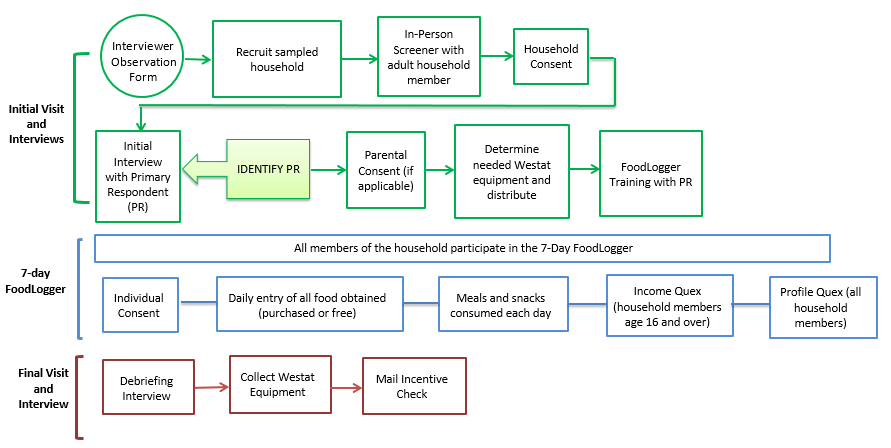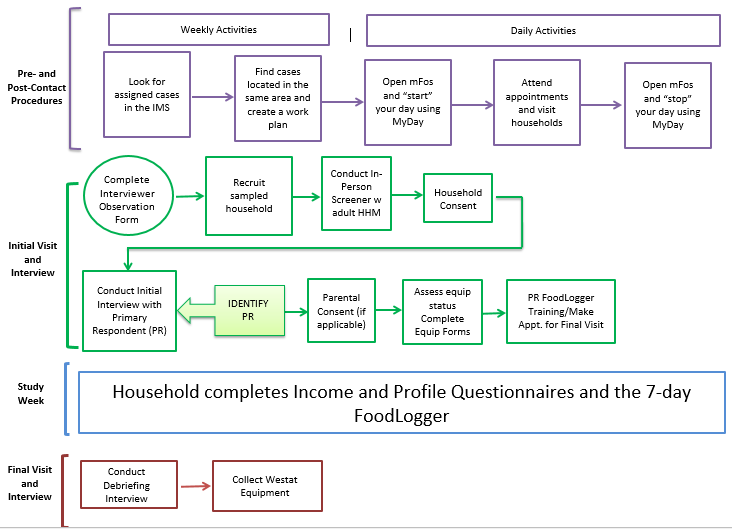Attachment H1 - NFS Field Test Overview (Interviewer Training Manual)
Attachment H1 - NFS Field Test Overview (Interviewer Training Manual) 09082021.docx
Field Test for the Second National Household Food Acquisition and Purchase Survey (FoodAPS-2)
Attachment H1 - NFS Field Test Overview (Interviewer Training Manual)
OMB: 0536-0077
National Food Study Field Test Overview |
1 |
The National Food Study (NFS) Field Test is a national study with a primary focus on the food people acquire. The NFS Field Test design draws on a comprehensive framework that distinguishes between food purchased at grocery stores or restaurants and food received for free like at a soup kitchen or a party at a friend’s house.
1.1 Introduction
The U.S. Department of Agriculture (USDA) Economic Research Service (ERS), together with USDA’s Food and Nutrition Service (FNS), is sponsoring the second National Household Food Acquisition and Purchase Survey (FoodAPS-2) Field Test. FoodAPS-2 is the second iteration of a nationally representative survey that collects detailed data on household food acquisitions. USDA is responsible for anticipating trends, identifying emerging issues, and conducting economic research to inform policy regarding the agriculture sector. The level at which USDA and the research community can assess the effects and drivers of national food market trends is heavily dependent on the availability of data. Historically, there has been limited national data on household food purchasing decisions. To address this gap, USDA designed FoodAPS-1,1 fielded in April 2012, and is currently planning FoodAPS-2. Using FoodAPS data, researchers can investigate the relationships among consumer choices, food prices, income, the community environment, and policy factors such as participation in food assistance programs.
NFS Field Test will collect data from 430 households through computer-assisted personal interviewing (CAPI) and a native smartphone app known as the FoodLogger that participating households will be able to download for free on their own smartphone. An eligible household will be loaned a Westat smartphone if necessary. Interviews are conducted in the sampled households’ homes at the beginning and end of a 7-day data collection week. The interviews cover topics such as participation in food assistance programs, household income, and food shopping habits. After completing the initial CAPI interviews, the respondents will be trained by a Westat field interviewer on how to record food in the FoodLogger each day. Respondents will be asked to record all acquired food (purchased or obtained for free) through the FoodLogger for a 7-day period. After the 7-day study period is over, a Westat interviewer will return to the home to conduct the final CAPI debriefing interview.
Figure 1-1: NFS Field Test Data Collection Activities Flowchart

Figure 1-1 above is a flowchart, which explains the order of data collection activities. The activities in green denote the initial visit events and interviews. The boxes in blue represent the activities during the 7-day study week and the red at the bottom show the final visit interviews.
1.2 NFS Field Test Objectives
The overall objectives of the NFS Field Test remain the same as the objectives identified for the FoodAPS-1 study. The six main study objectives established for FoodAPS-1 and the National Food Study Field Test are as follows:
Describe the food and beverage acquisition patterns of the population universe and subgroups (SNAP households, WIC households, low-income households with no SNAP or WIC participants, higher income households with no SNAP or WIC participants).
Characterize the nutritional quality of households’ food acquisitions.
Characterize the nature of the food environment around surveyed households.
Estimate the influence of income and prices on food acquisitions, including to the extent feasible, income, own-price, and cross-price elasticities for purchased food items (both at home and away.)
Assess levels of food security of sampled households and subgroups using the 30-day adult food security measure.
Assess levels of knowledge about diet, nutrition and health.
Assess how food acquisitions and food security outcomes differ for SNAP participants and low-income nonparticipants, and identify the factors that account for those differences.
1.3 The Sample
The United States Postal Service (USPS) address list, combined with Supplemental Nutrition Assistance Program (SNAP) administrative lists, served as the sampling frame of household addresses for the NFS Field Test. A three-stage sample design was used:
Selection of primary sampling units (PSUs) comprised of individual counties or groups of counties;
Selection of secondary sampling units (SSUs) consisting of Census block groups within sampled PSUs; and
Selection of household addresses within sampled SSUs.
The third stage occurs in three phases. First, an initial sample of household addresses from the USPS list is selected to receive the mail screener. The mail screener is a shortened version of the in-person screener and provides preliminary information on SNAP participation and income level. Based on the responses to the mail screener, a subsample of responding households will be selected for the in-person screener. An in-person screener will also be attempted for a subsample of households that did not respond by mail and all households selected from the SNAP list. Then based on the in-person screener responses, a subsample of households will be selected to continue with the main survey. The NFS Field Test national design calls for an oversample of SNAP households and a lower rate of higher-income households compared to the population.
The NFS Field Test national sample is in 12 PSUs in 9 states.
1.4 NFS Field Test Instruments
The NFS Field Test will use computer-assisted personal interview (CAPI) instruments and the FoodLogger (see Figure 1-1) to collect information from sampled households. You will be able to access these CAPI interviews using your Westat-provided laptop computer via the IMS (Interviewer Management System). Some instruments are available through mFOS (mobile Field Operating System) on your Westat iPhone as well. Study participants will access the FoodLogger on a smartphone. Participants who are unable to use the smartphone app will have the option of using a computer with an internet connection to access the Food Log to enter their food acquisitions.
|
|
|
|
|
|
|
|
|
|
|
|
1.6 Your Role on the NFS Field Test
As a field interviewer, your role is critical to the success of the NFS Field Test. Your data collection tasks on the NFS are described in detail throughout this manual and summarized in Figure 1-2. You will notice, this flowchart is very similar to the one presented above outlining the data collection activities. This flowchart focuses more on your role at each step in the data collection process. We will discuss each of these steps in detail throughout the manual.
Figure 1-2: NFS Field Test Field Interviewer Data Collection Tasks

In addition, you will have the following administrative responsibilities:
Complete the cases assigned to you in the time allotted for data collection;
Report to your supervisor during your scheduled report call times;
Accurately document miles driven and fieldwork time;
Enter daily hours and miles into an electronic timesheet; and
Fill out administrative forms and mail them to your supervisor or Westat’s home office.
1.7 Role of the Sampled Household
Unlike most other studies, in addition to providing responses to the interviewer-administered CAPI interviews, the sampled households in NFS Field Test will be responsible for collecting their own data by completing the NFS FoodLogger. After households are trained on how to use the FoodLogger, household members age 11 and older (if parent permission is obtained for those age 11-17) will be responsible for entering information on all of the food they get over a 7-day study period. Parents and guardians of children under age 11 will be responsible for entering food for their children. During the study week, we also expect each household member age 16 and older to complete an income questionnaire and profile questionnaire.
1Economic Research Service (ERS), U.S. Department of Agriculture (USDA). National Household Food Acquisition and Purchase Survey (FoodAPS). http://www.ers.usda.gov/foodaps.
|
|
|
|
Attachment H1 – NFS Field Test Overview (Interviewer Training Manual) |
1- |
|
| File Type | application/vnd.openxmlformats-officedocument.wordprocessingml.document |
| Author | Chantell Atere |
| File Modified | 0000-00-00 |
| File Created | 2022-10-14 |
© 2025 OMB.report | Privacy Policy